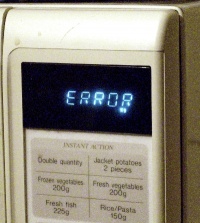Difference between revisions of "Fault Finding"
(asstd small) |
|||
| (3 intermediate revisions by the same user not shown) | |||
| Line 1: | Line 1: | ||
| − | + | [[image:Microwave Error 2681-9.jpg|right|200px]] | |
| − | + | '''Fault Finding''' is an important part of [[Special:Allpages|DIY]] work. There's more than one way to go about it. | |
| − | There | ||
| − | |||
| − | |||
| − | + | ===Guess & Replace=== | |
| + | A popular method for people with little idea where to begin. | ||
| − | + | Success is likely with very simple systems, eg with 2 or 3 parts. Success is unlikely with complex systems eg [[:Category:Appliances|electronic goods]], which contain 100s of parts. | |
| − | + | A fair bit of money is wasted through unnecessary replacement of working parts, but not needing to get someone in to do the job is an important saving. | |
| − | === | + | ===Replace the lot=== |
| − | A | + | A fair strategy when: |
| + | * faulty part replacement or [[Category:Repair|repair]] are impossible or impractical | ||
| + | * cost of fault finding is expected to exceed the cost of total replacement | ||
| + | * equipment has deteriorated badly. | ||
| + | * replacement equipment would deliver desired new features | ||
| + | * replacement equipment would deliver more [[Save energy|running cost savings]] that it costs | ||
| − | + | On the other hand a great deal of money is wasted every year by use of this method, and a huge amount of [[Disposal Options|landfill]] space taken up by a lot of kit that was often simple to [[:Category:Repair|repair]], but chucked out anyway. (And in many cases the replacement [[:Category:Appliances|equipment]] is worse than the kit removed.) | |
| − | === | + | ===Divide & Conquer=== |
| − | + | This is the most powerful means to find a fault, and is normally the method to use for complex systems. | |
| − | |||
| − | |||
| − | |||
| − | |||
| + | The idea is to narrow the fault down by seeing if its in one area or another of the system, and repeatedly narrowing it down to less and less possible parts, usually down to the one faulty part. The bad part can then be repaired or replaced. | ||
| + | This is the only method that can produce a good rate of successful repairs with complex equipment. The problem is it requires the skill to clearly distinguish several faulty parts of systems from working ones, and the time to do it. | ||
==See Also== | ==See Also== | ||
| − | [[:Category:Fault Finding]] | + | * [[:Category:Fault Finding]] |
| − | + | * [[Special:Allpages|Wiki Contents]] | |
| − | [[Special:Allpages|Wiki Contents]] | + | * [[Special:Categories|Wiki Subject Categories]] |
| − | + | * [[Re-use & Recycle]] | |
| − | [[Special:Categories|Wiki Subject Categories]] | ||
| Line 42: | Line 42: | ||
[[Category:Appliances]] | [[Category:Appliances]] | ||
[[Category:Electrical]] | [[Category:Electrical]] | ||
| + | [[Category:Repair]] | ||
Latest revision as of 12:50, 27 February 2011
Fault Finding is an important part of DIY work. There's more than one way to go about it.
Guess & Replace
A popular method for people with little idea where to begin.
Success is likely with very simple systems, eg with 2 or 3 parts. Success is unlikely with complex systems eg electronic goods, which contain 100s of parts.
A fair bit of money is wasted through unnecessary replacement of working parts, but not needing to get someone in to do the job is an important saving.
Replace the lot
A fair strategy when:
- faulty part replacement or are impossible or impractical
- cost of fault finding is expected to exceed the cost of total replacement
- equipment has deteriorated badly.
- replacement equipment would deliver desired new features
- replacement equipment would deliver more running cost savings that it costs
On the other hand a great deal of money is wasted every year by use of this method, and a huge amount of landfill space taken up by a lot of kit that was often simple to repair, but chucked out anyway. (And in many cases the replacement equipment is worse than the kit removed.)
Divide & Conquer
This is the most powerful means to find a fault, and is normally the method to use for complex systems.
The idea is to narrow the fault down by seeing if its in one area or another of the system, and repeatedly narrowing it down to less and less possible parts, usually down to the one faulty part. The bad part can then be repaired or replaced.
This is the only method that can produce a good rate of successful repairs with complex equipment. The problem is it requires the skill to clearly distinguish several faulty parts of systems from working ones, and the time to do it.
